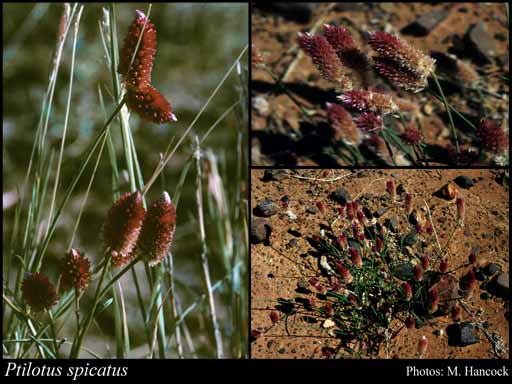- Reference
- Fl.Austral. 5:243 (1870)
- Conservation Code
- Not threatened
- Naturalised Status
- Native to Western Australia
- Name Status
- Current
Annual or perennial, herb, 0.25-1.5 m high. Fl. pink & white/red/purple, Mar to May or Aug. Clay, sandstone.

Scientific Description
Annuals, stems single or several, more or less erect, glabrescent or glabrous, with nodose hairs. Leaves present, 5-70 mm long, 0.5-5 mm wide, glabrous; basal rosette absent; cauline leaves alternate. Spikes magenta or red, ovoid or cylindrical, solitary, with densely arranged flowers. Bracts (2.5-)2.7-3.5(-4) mm long, colourless, hairy, awned or mucronate, with a prominent midrib. Bracteoles (3.2-)3.5-4(-4.5) mm long, colourless, hairy, awned or mucronate, with a prominent midrib. Outer tepals (4.2-)5.2-6 mm long, entire. Inner tepals (4.2-)5.2-6 mm long, with a basal tuft of hairs on inner face. Style (2.5-)3-3.3(-4.6) mm long, curved or straight, centrally fixed to ovary. Seeds (1.2-)1.3-1.5 mm long, glossy, brown. Distribution: Northern and Eremaean Botanical Region; IBRA regions: Central Kimberley, Dampierland, Northern Kimberley, Ord Victoria Plains, Victoria Bonaparte.
Distribution
- IBRA Regions
- Central Kimberley, Dampierland, Great Sandy Desert, Northern Kimberley, Ord Victoria Plain, Victoria Bonaparte.
- IBRA Subregions
- Berkeley, Fitzroy Trough, Hart, Keep, McLarty, Mitchell, Mount Eliza, Pentecost, Purnululu, South Kimberley Interzone.
- Local Government Areas (LGAs)
- Derby-West Kimberley, Halls Creek, Wyndham-East Kimberley.